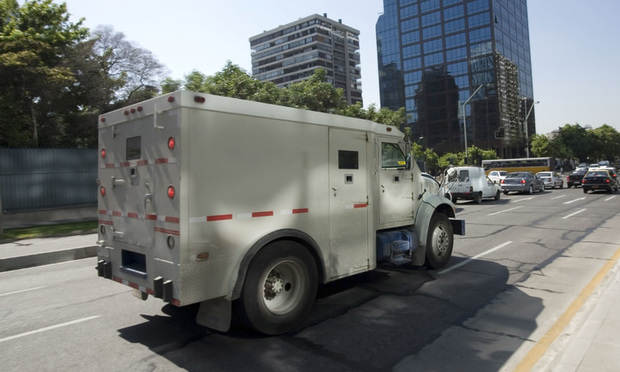L.A. Judge Blows Up Armored Car Driver Class Action
The next time I have some gold bullion to move, I'm calling Judge Highberger for a game plan.
November 08, 2018 at 12:18 PM
5 minute read
The original version of this story was published on Litigation Daily
 Being an armored car driver is no doubt an extremely stressful job. You're driving around in a truck full of money, for heaven's sake. There's a reason why caper movies so often feature armored truck robbery scenes.
Being an armored car driver is no doubt an extremely stressful job. You're driving around in a truck full of money, for heaven's sake. There's a reason why caper movies so often feature armored truck robbery scenes.
So I get that for the drivers, a 30-minute mid-day break would be nice—a chance to unwind, eat a sandwich, maybe even catch a little cat nap.
Except then there's an unattended truck full of money. It's kind of a problem.
On Tuesday, a Los Angeles County Superior Court judge rebuffed a would-be class action by armored car drivers who complained that they don't get a 30-minute (unpaid) off-duty break for a meal.
It's a nice win for security services company Garda and its legal team led by Malcolm Heinicke from Munger, Tolles & Olson, plus Keith Jacoby and Robert Blumberg from Littler Mendelson, even if it feels like a no-duh kind of decision. (The judge in a separate ruling also tossed overtime claims.)
California law requires employers to give employees either an unpaid half-hour off-duty for a meal, or else a paid half-hour while on duty, if the nature of the work prevents taking a break. (Or, if you're like me, you just eat at your desk all day long.)
The armored car drivers get the on-duty, paid-half hour.
It's not as if the plaintiffs don't understand why. As one driver admitted, he “couldn't clock out and go away from the truck and leave the money on the truck.”
 While in uniform, the driver said he has to be constantly vigilant whenever he leaves the vehicle. Even if he just “went into, say, McDonalds to get a Coke,” he said that he has to be on alert so no one could use him as “a hostage to try to get into the truck.”
While in uniform, the driver said he has to be constantly vigilant whenever he leaves the vehicle. Even if he just “went into, say, McDonalds to get a Coke,” he said that he has to be on alert so no one could use him as “a hostage to try to get into the truck.”
Gulp.
Still, the plaintiffs offered several suggestions how they could get a real break, like maybe if there were three guards per truck instead of two?
But Judge William Highberger (who was a partner at Gibson, Dunn & Crutcher before he became judge in 1998) pretty much annihilated that idea.
“If each member of a three-person team was dropped off while the others continued the route (eventually looping back to pick him up), that [driver] would be a particularly prone target who would need to remain alert, especially since he would have no partner monitoring him and even minimal casing would lead thieves to know that the armored vehicle would come back in 30 minutes to retrieve him,” he wrote.
Plus, it would wreak havoc with the routes.
Aside from the whole thing being a bad idea, the judge also noted that “California law does not require employers to restructure their basic operations to permit off-duty meal periods.”
Um, well, what if the drivers changed or covered up their uniforms when they went on break?
“[T]hieves surveilling the armored vehicle are not likely to be fooled into thinking that a plaintiff exiting the vehicle is not a departing [driver] simply because he is trying to cover his uniform,” Highberger wrote. “Moreover, there is no disguising an armored vehicle.”
The plaintiffs also suggested they could get their off-duty breaks by parking their armored vehicles in police station parking lots or other safe spots.
So yeah, a few problems there too.
The plaintiffs “offer no evidence to suggest police forces of other third parties would be willing to host a crime target on their premises while those charged with protecting that target went on a break.”
Oh. Well, when you put that way…
Moreover, Highberger noted, “Any time the armored vehicle is parked, the risk of armed attack increases, and this risk would increase even more if the vehicle was parked for a full 30 minutes as part of its scheduled route.”
I'm feeling like if he wasn't a judge, Highberger could have an alternate career as a security consultant. He seems to have a better handle on all this than the drivers do.
Let's just say the next time I have some gold bullion to move, I'm calling him for a game plan.
We hope you enjoyed this excerpt from Litigation Daily, the exclusive source for sharp commentary on mega court battles, winning strategies and the issues that obsess elite litigators. Click here to subscribe.
This content has been archived. It is available through our partners, LexisNexis® and Bloomberg Law.
To view this content, please continue to their sites.
Not a Lexis Subscriber?
Subscribe Now
Not a Bloomberg Law Subscriber?
Subscribe Now
NOT FOR REPRINT
© 2025 ALM Global, LLC, All Rights Reserved. Request academic re-use from www.copyright.com. All other uses, submit a request to [email protected]. For more information visit Asset & Logo Licensing.
You Might Like
View All
Kirkland & Ellis Team Secures $19.4M Award for Transportation Tech Company in Patent Infringement Case
3 minute read
UPS Accused of Failing to Provide Suitable Bathroom Facilities, Ways to Dispose of 'Urine-Filled Containers' for Drivers
4 minute read
Judge Pauses Approval of $725M Facebook Settlement After New Mexico AG Shows Up
6 minute read
Amid Swirl of Investigations, Self-Driving Tech Firm TuSimple Names New GC
3 minute readTrending Stories
- 1Bribery Case Against Former Lt. Gov. Brian Benjamin Is Dropped
- 2‘Extremely Disturbing’: AI Firms Face Class Action by ‘Taskers’ Exposed to Traumatic Content
- 3State Appeals Court Revives BraunHagey Lawsuit Alleging $4.2M Unlawful Wire to China
- 4Invoking Trump, AG Bonta Reminds Lawyers of Duties to Noncitizens in Plea Dealing
- 522-Count Indictment Is Just the Start of SCOTUSBlog Atty's Legal Problems, Experts Say
Who Got The Work
J. Brugh Lower of Gibbons has entered an appearance for industrial equipment supplier Devco Corporation in a pending trademark infringement lawsuit. The suit, accusing the defendant of selling knock-off Graco products, was filed Dec. 18 in New Jersey District Court by Rivkin Radler on behalf of Graco Inc. and Graco Minnesota. The case, assigned to U.S. District Judge Zahid N. Quraishi, is 3:24-cv-11294, Graco Inc. et al v. Devco Corporation.
Who Got The Work
Rebecca Maller-Stein and Kent A. Yalowitz of Arnold & Porter Kaye Scholer have entered their appearances for Hanaco Venture Capital and its executives, Lior Prosor and David Frankel, in a pending securities lawsuit. The action, filed on Dec. 24 in New York Southern District Court by Zell, Aron & Co. on behalf of Goldeneye Advisors, accuses the defendants of negligently and fraudulently managing the plaintiff's $1 million investment. The case, assigned to U.S. District Judge Vernon S. Broderick, is 1:24-cv-09918, Goldeneye Advisors, LLC v. Hanaco Venture Capital, Ltd. et al.
Who Got The Work
Attorneys from A&O Shearman has stepped in as defense counsel for Toronto-Dominion Bank and other defendants in a pending securities class action. The suit, filed Dec. 11 in New York Southern District Court by Bleichmar Fonti & Auld, accuses the defendants of concealing the bank's 'pervasive' deficiencies in regards to its compliance with the Bank Secrecy Act and the quality of its anti-money laundering controls. The case, assigned to U.S. District Judge Arun Subramanian, is 1:24-cv-09445, Gonzalez v. The Toronto-Dominion Bank et al.
Who Got The Work
Crown Castle International, a Pennsylvania company providing shared communications infrastructure, has turned to Luke D. Wolf of Gordon Rees Scully Mansukhani to fend off a pending breach-of-contract lawsuit. The court action, filed Nov. 25 in Michigan Eastern District Court by Hooper Hathaway PC on behalf of The Town Residences LLC, accuses Crown Castle of failing to transfer approximately $30,000 in utility payments from T-Mobile in breach of a roof-top lease and assignment agreement. The case, assigned to U.S. District Judge Susan K. Declercq, is 2:24-cv-13131, The Town Residences LLC v. T-Mobile US, Inc. et al.
Who Got The Work
Wilfred P. Coronato and Daniel M. Schwartz of McCarter & English have stepped in as defense counsel to Electrolux Home Products Inc. in a pending product liability lawsuit. The court action, filed Nov. 26 in New York Eastern District Court by Poulos Lopiccolo PC and Nagel Rice LLP on behalf of David Stern, alleges that the defendant's refrigerators’ drawers and shelving repeatedly break and fall apart within months after purchase. The case, assigned to U.S. District Judge Joan M. Azrack, is 2:24-cv-08204, Stern v. Electrolux Home Products, Inc.
Featured Firms
Law Offices of Gary Martin Hays & Associates, P.C.
(470) 294-1674
Law Offices of Mark E. Salomone
(857) 444-6468
Smith & Hassler
(713) 739-1250






